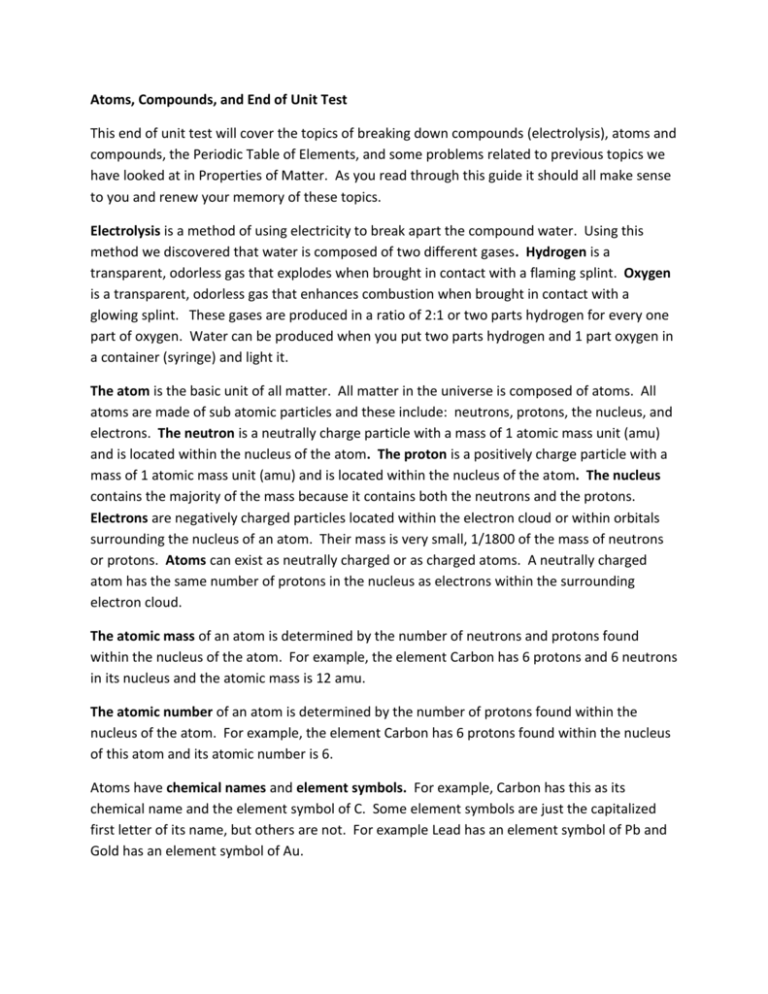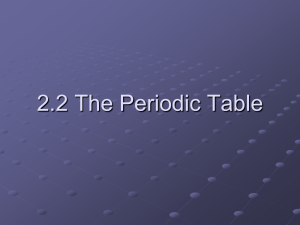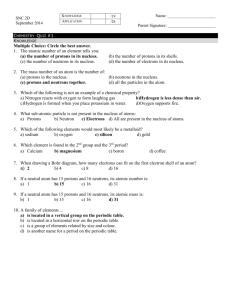Atoms, Compounds, End of Module Test
advertisement

Atoms, Compounds, and End of Unit Test This end of unit test will cover the topics of breaking down compounds (electrolysis), atoms and compounds, the Periodic Table of Elements, and some problems related to previous topics we have looked at in Properties of Matter. As you read through this guide it should all make sense to you and renew your memory of these topics. Electrolysis is a method of using electricity to break apart the compound water. Using this method we discovered that water is composed of two different gases. Hydrogen is a transparent, odorless gas that explodes when brought in contact with a flaming splint. Oxygen is a transparent, odorless gas that enhances combustion when brought in contact with a glowing splint. These gases are produced in a ratio of 2:1 or two parts hydrogen for every one part of oxygen. Water can be produced when you put two parts hydrogen and 1 part oxygen in a container (syringe) and light it. The atom is the basic unit of all matter. All matter in the universe is composed of atoms. All atoms are made of sub atomic particles and these include: neutrons, protons, the nucleus, and electrons. The neutron is a neutrally charge particle with a mass of 1 atomic mass unit (amu) and is located within the nucleus of the atom. The proton is a positively charge particle with a mass of 1 atomic mass unit (amu) and is located within the nucleus of the atom. The nucleus contains the majority of the mass because it contains both the neutrons and the protons. Electrons are negatively charged particles located within the electron cloud or within orbitals surrounding the nucleus of an atom. Their mass is very small, 1/1800 of the mass of neutrons or protons. Atoms can exist as neutrally charged or as charged atoms. A neutrally charged atom has the same number of protons in the nucleus as electrons within the surrounding electron cloud. The atomic mass of an atom is determined by the number of neutrons and protons found within the nucleus of the atom. For example, the element Carbon has 6 protons and 6 neutrons in its nucleus and the atomic mass is 12 amu. The atomic number of an atom is determined by the number of protons found within the nucleus of the atom. For example, the element Carbon has 6 protons found within the nucleus of this atom and its atomic number is 6. Atoms have chemical names and element symbols. For example, Carbon has this as its chemical name and the element symbol of C. Some element symbols are just the capitalized first letter of its name, but others are not. For example Lead has an element symbol of Pb and Gold has an element symbol of Au. Elements are pure substances that cannot be broken down into other substances by chemical or physical means: (except by a nuclear reaction). An example of an element would be hydrogen gas. Compounds are pure substances consisting of two or more elements combined. For example, water consists of the elements hydrogen and oxygen combined. The Periodic Table of Elements is a table that contains information about all of the known elements. Each square on the table includes an element’s name, chemical symbol, atomic number, and atomic mass. Some tables contain other information about the element. Periodic means happening at regular intervals and the rows of the table are referred to as Periods. Periodic law states that properties of elements change periodically with the elements atomic number. Vertical columns are called groups. Elements in the same group often have similar chemical and physical properties. For this reason, a group is also called a family. An example of a group would be the Noble Gases. These are non-reactive elements found within the far right group on the periodic table. In the Periodic Table of Elements, elements are classified as metals, metalloids, and nonmetals. Metals have some properties such as being a solid at room temperature with the exception of mercury. Metals look shiny to some degree and are good conductors of electric current. They are ductile (can be drawn into thin wires) and malleable (flattened into sheets and bendable). Metalloids have some properties of metals and some properties of non-metals. Non-metals are mostly gases at room temperature and have properties that are opposite of the properties of metals. They are mostly not shiny, poor conductors, and not malleable or ductile. Sulfur is an example of a non-metal element.








